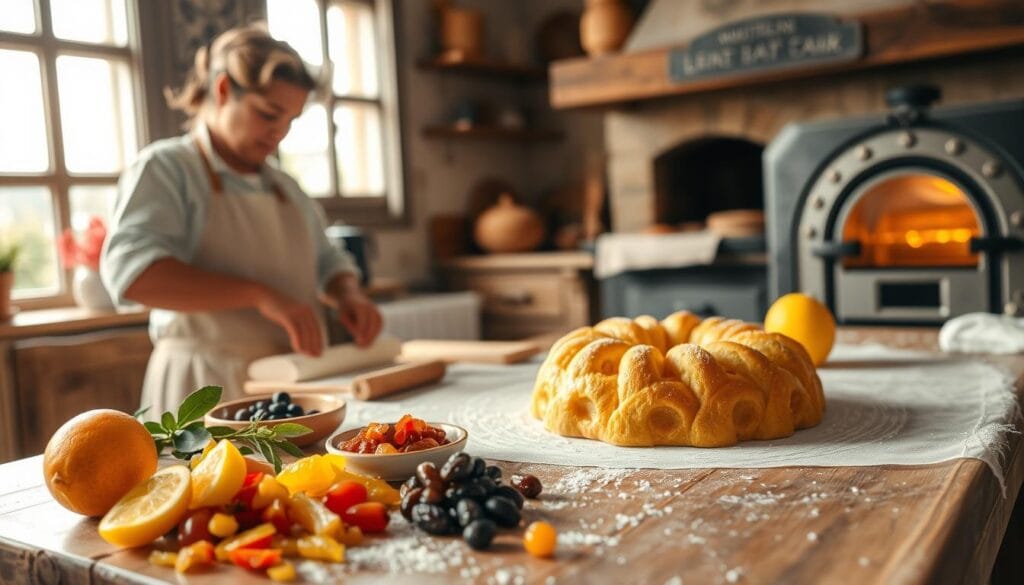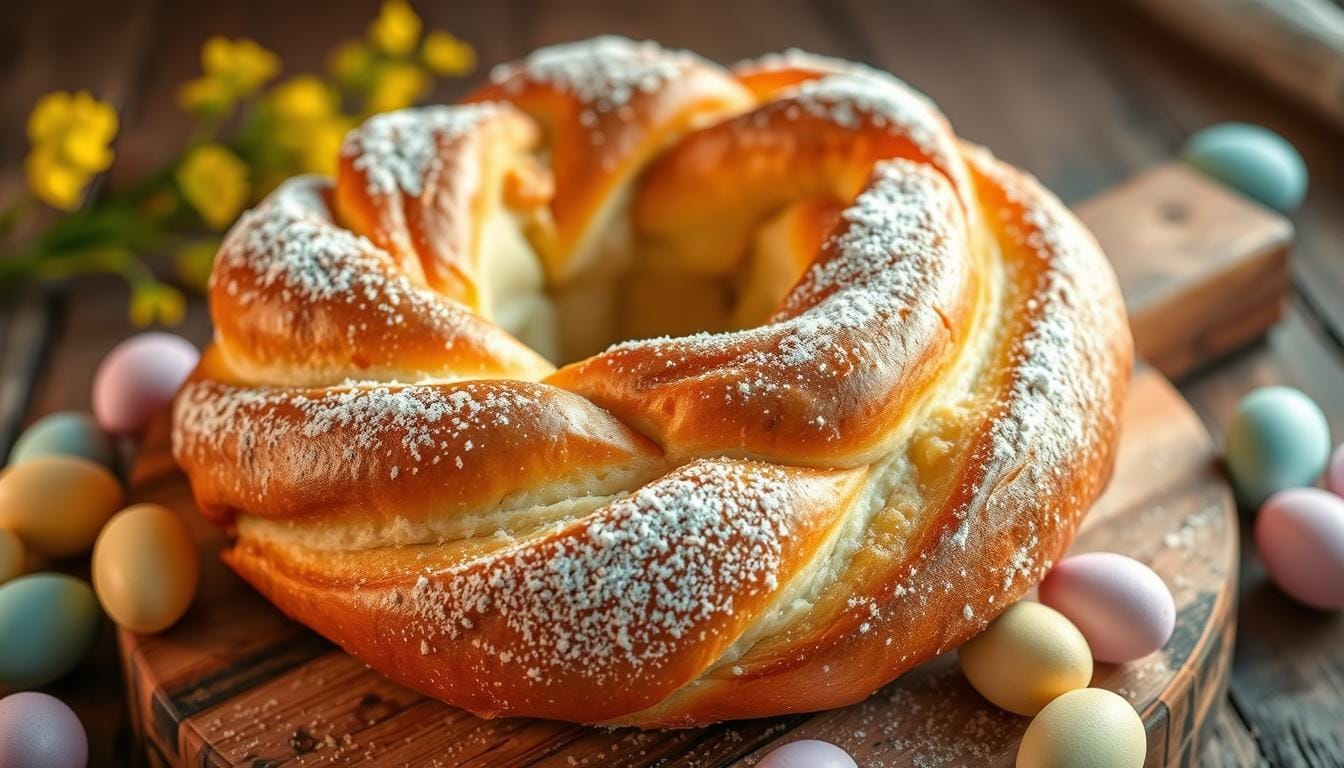Ciambella di Pasqua 2025: Scopri Un Morso di Storia e tradizioni nella Fantastica Italia
Imagine waking up on Easter morning to the sweet aroma of freshly baked pastry filling your home. This isn’t just any treat—it’s a symbol of joy, family, and centuries of Italian tradition. The Ciambella di Pasqua is more than a dessert; it’s a celebration on a plate.
Originating from Italy’s heartland, this ring-shaped delight has graced tables for generations. Unlike its cousin, the colomba, it boasts a lighter texture and a subtle citrus or vanilla flavor. Families gather around it, sharing stories and savoring every bite.
From Abruzzo to Sicily, each region adds its twist—some drizzle it with chocolate, while others serve it with gelato. Whether enjoyed at breakfast or as an afternoon snack, it’s a taste of la dolce vita.
Table of Contents
Key Takeaways
- A beloved Easter dessert with deep cultural roots in Italy.
- Features a soft, ring-shaped design, distinct from colomba.
- Often paired with coffee, milk, or gelato for a festive touch.
- Regional variations include chocolate or citrus flavors.
- Central to family gatherings and holiday traditions.
The History and Tradition of Ciambella di Pasqua
The scent of citrus and warm dough fills Italian kitchens every spring, signaling the arrival of a cherished holiday treat. These ring-shaped pastries, known as *ciambelle*, are steeped in symbolism. Eggs and citrus zest represent rebirth, mirroring Easter’s themes of renewal.
A Sweet Symbol of Italian Easter Celebrations
For centuries, families have baked these treats at *casa* as a centerpiece for gatherings. The dough’s golden hue and delicate crumb reflect the joy of the season. In many homes, the aroma of baking is as treasured as the first bite.
Regional Variations: From Marche to Abruzzo
Italy’s diverse regions put unique spins on the classic recipe. *Marche’s* version features *canditi* (candied fruit), amaretto, and orange zest, whipped up in just 30 minutes. Meanwhile, *Abruzzo* relies on *lievito di birra* (beer yeast) and cinnamon, with dough rising for 5 hours.
| Region | Key Ingredients | Prep Time | Signature Flavor |
|---|---|---|---|
| Marche | Canditi, amaretto, orange zest | 30 mins | Citrusy, nutty |
| Abruzzo | Lievito di birra, cinnamon | 5 hours | Warm, spiced |
In *Abruzzo*, baking is a family affair. Large batches are made to share with relatives, turning the kitchen into a hub of laughter and storytelling. Whether you prefer the quick *ricette* of Marche or the slow-rise tradition of Abruzzo, each bite carries a taste of history.
Essential Ingredients for the Perfect Ciambella
Creating this Italian classic starts with quality ingredienti. The right mix ensures a soft texture and rich flavor. Let’s break down what you’ll need.

Flour and Sweeteners
Use farina 00 or farina 0 for the best structure. These finely milled flours create a light crumb. For sweetness, zucchero (sugar) balances the dough. Some recipes use 190g, while others go up to 300g for a richer taste.
Eggs and Dairy
Uova (eggs) bind the batter and add richness. Always use room-temperature eggs for even mixing. Latte (milk) keeps the dough moist. Warm it slightly to help activate the lievito (yeast). For a lactose-free option, almond milk works well.
Fats and Flavor Boosters
Olio di semi (seed oil) or butter adds tenderness. Citrus zest, like scorza di limone, brightens the flavor. Vanilla or amaretto can deepen the aroma. Candied fruits or chocolate chips offer texture variations.
- Quick recipes use baking powder for speed.
- Traditional versions rely on yeast for a slow rise.
- Substitute canditi with nuts or dried fruit for twists.
With these ingredienti, your dough will be fluffy and flavorful. Next, we’ll dive into mixing and baking techniques.
How to Make Ciambella di Pasqua at Home
Master the art of baking this festive treat with simple, step-by-step instructions. Whether you’re a beginner or a seasoned baker, these tips ensure a flawless result every time.

Preparing the Batter: Tips for a Fluffy Texture
Start by whisking uova (eggs) and zucchero with fruste elettriche until creamy. Gradually add latte and olio di semi to avoid curdling. For extra lightness, sift farina 00 and lievito together before folding into the impasto.
Gently mix in citrus zest or canditi to keep the batter airy. Let it rest for 10 minutes—this helps the gluten relax for a tender crumb.
Baking to Perfection: Time and Temperature Guide
Preheat your forno to 170°C for a classic 45-minute bake or 180°C for 35 minutes if using a smaller mold. The pastry is done when a toothpick comes out clean.
- For even baking: Rotate the pan halfway through.
- Cool completely on a rack before decorating to prevent glaze melt.
Decorating with Glaze and Colorful Sugars
Mix zucchero a velo with lemon juice for a glossy glaze. Drizzle over the cooled pastry, then add zuccherini or chocolate shavings. For a showstopper, try royal icing (albume + sugar) piped into delicate patterns.
Pro tip: Use a 22cm mold for thicker slices or a 26cm ring for a traditional look. Either way, this ricetta promises a centerpiece worthy of your Easter table.
Creative Twists and Serving Ideas
Ready to elevate your Easter dessert game? Try these creative twists on a classic Italian favorite. Whether you’re baking for family or gifting to friends, these ideas will make your dolci stand out.
Alternative Flavors: Citrus, Chocolate, and Nuts
Refresh the traditional sapore with zesty lemon or orange zest. For richer ricette, fold in dark cioccolato chunks or toasted almonds. The crunch of granella di frutta secca adds delightful texture.
Dietary restrictions? Swap eggs for flaxseed and use plant-based latte. These vegan versions taste just as indulgent. The dough adapts well to different tipo of add-ins.
Pairing Suggestions: Coffee, Gelato, and More
Serve warm slices with strong espresso for breakfast. In the afternoon, try it with sweet dessert wine. « The contrast of warm pastry and cool gelato creates magic, » says Roman baker Luca Bianchi.
For showstopping presentation:
- Dust with zuccherini colored for festive flair
- Drizzle with melted chocolate using semi-sweet chips
- Package mini ciambelle with pastel ribbons as edible gifts
Want something extra? Top with vanilla gelato and fresh berries. The possibilities are endless when you play with flavors and presentations.
Conclusion
Every slice tells a story—of family, festivity, and Italy’s rich culinary legacy. This ring-shaped dolce connects generations through cucina, whether you honor tradizione or try new ricette with a twist.
Perfect for Easter brunch, it’s as practical as it is symbolic. Gather at casa to bake, share, and snap photos of your creations. Tag them online to inspire others!
More than a dessert, it’s a taste of history. Whether classic or creative, each bite celebrates Italy’s love for food, family, and joy.
FAQ
What is the significance of Ciambella di Pasqua in Italian culture?
Are there regional differences in how Ciambella di Pasqua is made?
What are the key ingredients needed to make Ciambella di Pasqua?
How do you achieve a fluffy texture in the batter?
What is the ideal baking time and temperature for Ciambella di Pasqua?
Can I add creative twists to the traditional recipe?
What are some great pairings for Ciambella di Pasqua?
Source Links
- La Cassata Siciliana 2025: Provate Il Dolce Pasquale Che Porta La Sicilia In Tavola
- Bake The Beste Amaretti Dolci: Delicious Italian Almond Cookies 2025
- Torta Di Ricotta E Limone 2025:davvero Un Dessert Perfetto Per La Primavera, Gusto Fresco E Delicato


Laisser un commentaire